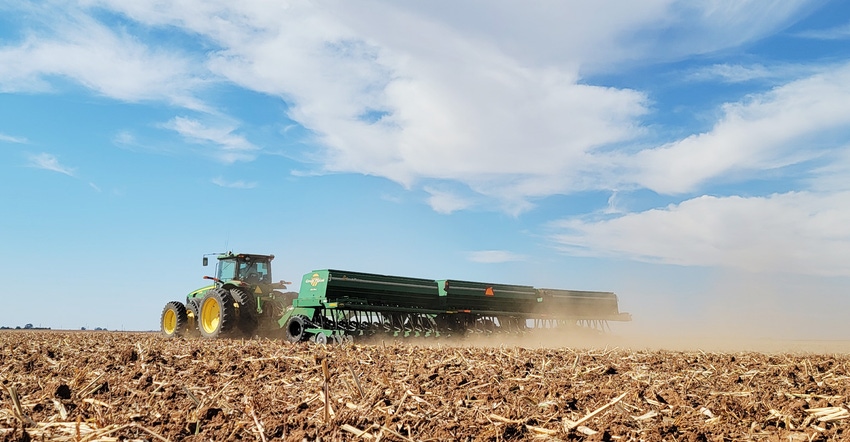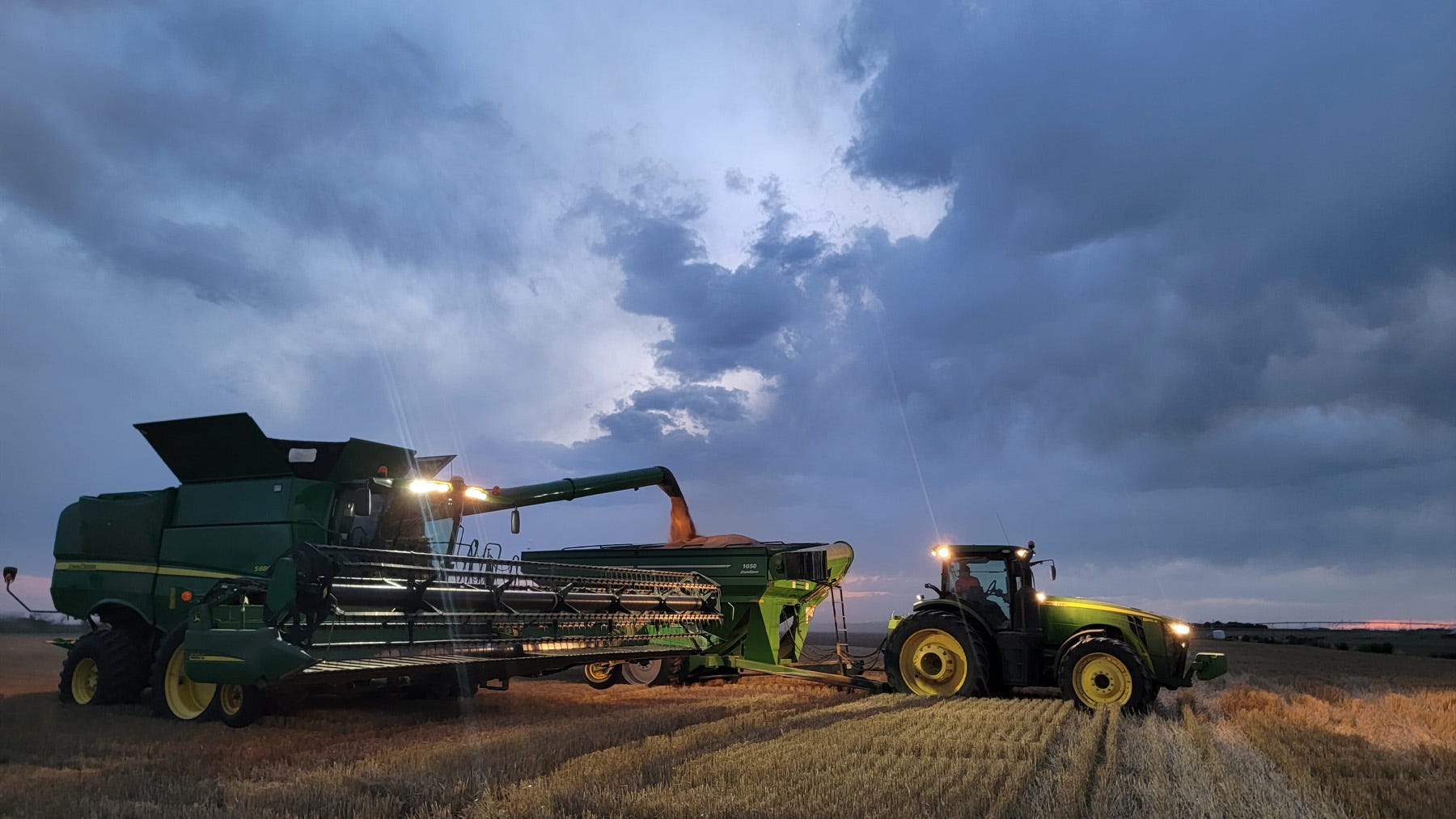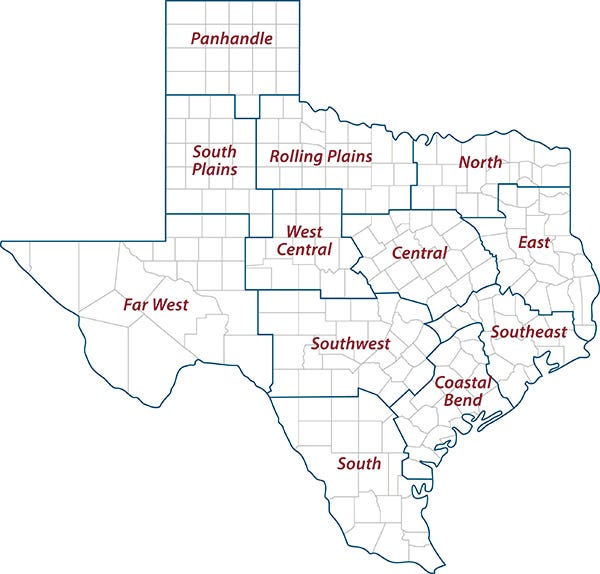
Timely rainfall in some areas has been highly beneficial for the fall wheat crop, according to a Texas A&M AgriLife Extension Service expert.
Jourdan Bell, AgriLife Extension agronomist, Amarillo, said she expects to see above-average acres planted in the northern High Plains region as a result of improved soil moisture conditions, but planting in the central High Plains is delayed because of warm, dry conditions. Many fields planted southwest of Amarillo have not emerged or have already dried out.
Planning, planting
Rainfall has been spotty, but planted wheat fields in the most northern counties are doing well, Bell said. Crop progress should continue to improve in areas that receive timely rains, she noted.

The Russia-Ukraine war continues to impact the wheat market. (Photo by Shelley E. Huguley)
Wheat has an extremely long growing season. Many producers use wheat as grazing land for their beef cattle herds during the winter months. Fields intended for grazing were planted from late August to early September although planting conditions are typically ideal for wheat in October.
“When planting in October, we are escaping early fall insect pest pressure and reducing the risk for wheat curl mite infestation, which will lead to wheat streak mosaic virus,” Bell said.
Producers who are planting their wheat crop solely for grain have a longer planting window and can wait to plant their crop until mid-to-late November.
Mark Welch, AgriLife Extension grain marketing economist, Bryan-College Station, said he expects the 2024 wheat crop to have a better production environment since weather patterns are transitioning from La Niña to El Niño.
“We have noticed that wheat produces better yields during the El Niño weather events,” Welch said. “2024 crops have an advantage because this El Niño is supposed to be a relatively strong one.”
World wheat market
The world wheat market is driven by what Russia does, Welch said, and the conflict in Ukraine continues to be part of that influence.
“Wheat is a globally traded commodity, and something as disruptive as war in a region where about 15% of the world’s wheat is grown can impact wheat prices,” Welch said. “Those impacts to prices matter to U.S. producers who produce 6-8% of total world wheat.”

"...Russia holds more leverage over the world wheat market in a time that world wheat supplies continue to get tighter,” says Grain Marketing Economist Mark Welch. (Photo by Shelley E. Huguley)
Over the last few years, Russia has been supplying more wheat to the world market; and price fluctuations have become increasingly dependent on what Russia does: production, exports, geopolitical events.
“How much we produce, how much we export, and other political events — Russia holds more leverage over the world wheat market in a time that world wheat supplies continue to get tighter,” Welch said.
Since 2020, and the Russian invasion of Ukraine earlier this year, prices have risen from below $4 per bushel to as high as $12 per bushel. Last week’s wheat prices in Texas were $5.90 per bushel, about the same as the summer of 2021.
“The U.S. is self-sufficient in producing wheat,” said Welch. “We import about 120 million bushels of wheat in a typical marketing year, about 5% of total use. All these factors matter for price implications in a world market for a key food grain.”
AgriLife Extension district reporters compiled the following summaries:

CENTRAL
The week started with lows dipping into the 30s in some areas but reached record-high temperatures to end the week. The conditions were dry and windy. Stock tanks and rivers maintained their low water levels. The harvest of pecans had begun with very little to harvest. The cotton acreage that had not been harvested was mostly abandoned. Some winter wheat and oats were sowed, with the majority intended for grazing. Other producers were still preparing to plant their wheat and oats. Ryegrass began emerging and quickly drying out due to the lack of moisture in some areas, and other areas reported their crop looked promising. Many tree issues were reported, along with various vegetation-related diseases, such as black spot and powdery mildew. Fall armyworms were observed in some fields, with the potential for an outbreak high due to forecasted rainfall and cooler temperatures. Livestock were being supplemented, and the last hay was being baled. Cattle remained in good body condition.
ROLLING PLAINS
Most counties in the district were close to finishing up planting winter wheat. All producers were hopeful that rain would get the crop up and give it a good start going into the fall. Rain was also needed for area pastures and livestock drinking sources. Most livestock were being fed hay and supplements due to poorer-than-average pasture conditions. The hope was with good rains and a strong start on the wheat, cattle could be turned out to graze wheat pastures.
COASTAL BEND
Mild temperatures, low humidity and a week of sunshine allowed fieldwork to continue with disking, spraying and putting up rows. Some producers were already wanting to begin fertilizing. All crops were harvested except the second crop of rice. Winter pasture planting continued. Some hay produced a final cutting in areas with enough rain for sufficient growth. Hay supplies were getting lower and questionable for the winter. There have been reports of dead spots across pastures and hay fields, which will take time to fill back in and will reduce yields. Armyworms continued to be present but haven’t been as bad as expected after the recent rains and lush growth. Livestock producers continued to wean and cull cows. Some producers continued to supplement with protein and hay. Pecan harvest was in full swing, with yields being fair. Some areas where pecans were better managed were producing good quality yields.
EAST
The region needs more rain. Soil conditions worsened. Pasture and rangeland conditions were fair to good despite the lack of rainfall. Subsoil and topsoil conditions were adequate to short. Producers continued to struggle for one last cutting of hay. Livestock were doing fair to good with some supplementation taking place. Hay supplies were already short for many producers. Armyworms infested pastures and hay meadows in many areas. Gregg County reported problems with wild pigs and gophers.
SOUTH PLAINS
Mild temperatures allowed producers to apply harvest aids to cotton. Farmers were busy preparing to harvest cotton. A few started stripping; others were waiting a few more days before the defoliated plants were ready to be harvested. The first bale of cotton was ginned at a local cooperative. This year, most of the dryland cotton in the districts was a complete loss. Those fields were being prepared for winter wheat crops. Producers planted winter cover crops like wheat and winter peas and continued cutting hay and grain. Corn was harvested across the area, and most sorghum was cut. Cattle were in good condition.
PANHANDLE
The region continued to have high winds and very dry conditions. Some producers dusted in wheat crops in hopes of some moisture. Irrigated wheat progressed with several producers starting wells for grazing. Some counties completed corn harvest and grain sorghum harvest started. Silage choppers continued with some producers wrapping up the year very quickly. Cover crops were planted on several fields from which forage for silage was harvested. Defoliation of cotton was in progress. Cotton harvest was expected to be extremely limited due to adverse weather conditions during the planting season. Dry conditions affected pastures and rangeland, causing it to go dormant.
NORTH
Pastures and rangelands were fair to very poor for most of the counties. Subsoil and topsoil moisture was reported short. Fall temperatures dropped to the low 50s at night throughout the region. Much-needed rain would help with grass growth and get seeds planted. Hay harvest continued for some areas throughout the region. Some producers were feeding hay throughout October. Volunteer ryegrass was starting to germinate. Winter wheat planting had increased and was doing well. The grasshopper population was on the rise. There were multiple reports of urban trees showing disease symptoms; most were oak trees. Livestock were in good condition and continuing to improve.
FAR WEST
Temperatures were about average for this time of the year. The daytime temperatures were in the mid-80s and topping off at 90, with overnight temperatures in the 50s. The region needed rain to improve soil moisture and rangeland conditions. Subsoil moisture remained steady, ranging from short to adequate. The lack of rain led to poor crop conditions and was the biggest contributing factor to rangeland degradation. Cotton harvest continued to push along, with extremely poor yields being reported. Producers were considering having insurance adjusters come out and look at irrigated acres due to yields being even lower than initially expected. Ginning was expected to start up later in the week. Cotton was harvested and baled. Wheat planting continued behind harvested cotton as well as plowed dryland acres. Wheat acres were expected to be up again this year. Pumpkins and some late-season watermelon and cantaloupe were being harvested. Livestock were in fair condition, but producers were still supplementing with hay and grain. Producers shipped out all the late lambs, kids and older ewes and nannies.
WEST CENTRAL
Temperatures stayed in the lower 80s to upper 70s, with little to no rainfall in the district. Areas that received little rain have noticed an increase in armyworms. Soil has continued to dry out. Producers increased field preparation and small grain planting. Producers who already planted small grains were noticing poor root establishment. The cotton crop was in poor condition, and few acres were expected to be harvested; producers expecting harvest completed spraying their cotton. Some producers were cutting the last of their hay. Pecan trees were suffering from the drought. Rangeland and pasture conditions were lacking forage. Warm season forage growth slowed with cooler nighttime temperatures. Fall cattle work and calf shipping continued. Dust pneumonia was a problem in livestock. Producers continued supplemental feeding livestock and took water to their herds in drought-stricken areas.
SOUTHEAST
Dry conditions continued with mild temperatures that offered relief. Cooler nights slowed forage growth. Rice harvest was completed. Producers continued cutting and bailing hay. The burn ban was lifted. Cotton harvest continued. Cooler temperatures slowed the growth of warm-season plants, and trees were beginning to enter dormancy. Many producers noticed an increase in the armyworm population. Available surface water for livestock was at 65%, and some producers started spreading lime. Producers continued supplemental feeding for their livestock; many producers continued culling cattle.
SOUTHWEST
The area experienced prolonged dry weather with limited rainfall over the past week. While the intermittent rain and cooler temperatures helped maintain soil moisture and range conditions, it wasn’t sufficient to significantly improve the situation. Dry conditions persisted, and there wasn’t much change compared to the previous week. Lack of precipitation remained a concern to some producers who continued to sell livestock off weekly, but numbers were decreasing. Livestock supplementation continued.
SOUTH
Cooler temperatures swept the region, with highs in the mid-80s. Producers were harvesting peanuts and planting small grains. Some producers sprayed in preparation for armyworms. Strawberry producers were putting down fertilizer and mulch. Early variety oranges were being harvested while other citrus producers with late-season varieties tried to irrigate and fertilize their trees to improve fruit size and yield. Cotton harvest was completed. Rangeland and pastures were in good condition with cooler nighttime temperatures. Producers continued cutting and baling hay. Producers continued supplemental feeding for their herds. Local markets reported average volumes with strong prices for all classes of beef cattle.
Read more about:
GrazingAbout the Author(s)
You May Also Like




